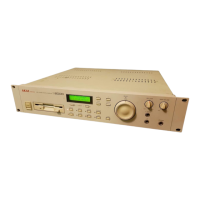PROGRAM EDIT
Page 66 S2000 Operator’s Manual - Version 1.30
PROGRAM EDIT
Once you have a few programs in memory, it may be that you need to edit them to make them
more suitable for your application. They may need simple tweaking such as altering the attack
times or the filter cutoff or adding a bit of vibrato. You may want to totally re-program the sound
or create a new program for the latest batch of samples you have made. Whatever it is you want
to do with a program, all this is done in SINGLE EDIT or MULTI EDIT. But before we look at the
program editing functions, let’s first look at what a program is.
The EDIT PROGRAM mode is where you assemble your raw, edited samples for playback. In
the EDIT SAMPLE mode, the samples are unprocessed by envelopes, vibrato, etc.. If they
have been looped, it is quite possible they have lost all their dynamics - this can be overcome
in EDIT PROGRAM. Furthermore, because of powerful synthesiser functions, the S2000 can
be used to play and process samples much like an analogue synthesiser. With 2 low frequency
oscillators (LFOs), ADSR and multi-stage envelope generators, resonant filters, panning and
more, the S2000 can radically transform any sound offering the creative musician and
programmer endless possibilities. In short, what it means is that as well as owning a superb
sampler, you also have a very excellent and versatile analogue style synthesiser.
On top of this, you may set sophisticated keyboard splits and layers, set velocity switching and
crossfading, assign samples to individual outputs and/or pan them in the stereo outputs as well
as tune and transpose your samples. You may also set MIDI parameters for your sample(s).
“But”, you may be asking “why have programs? Why not just play samples from EDIT
SAMPLE?” A good question. The reason we have EDIT PROGRAM is because raw samples,
however much you may have trimmed, looped, crossfaded, stretched, etc., are only half the
story. In EDIT SAMPLE, you can only play one sample at a time spanning the entire keyboard
range whereas in a program, you can assign them to different areas of the keyboard for
playback. This is known as ‘multi-sampling’.
Multi-sampling is the technique where you take several samples of one instrument across its
range or where you take several samples of different instruments (such as drums, for example).
Aside from all the fun things you can do with envelope shaping, filtering and so forth, it is in a
program that you map all these multi-samples across the keyboard. To do this, we place the
samples into what we call KEYGROUPS.

